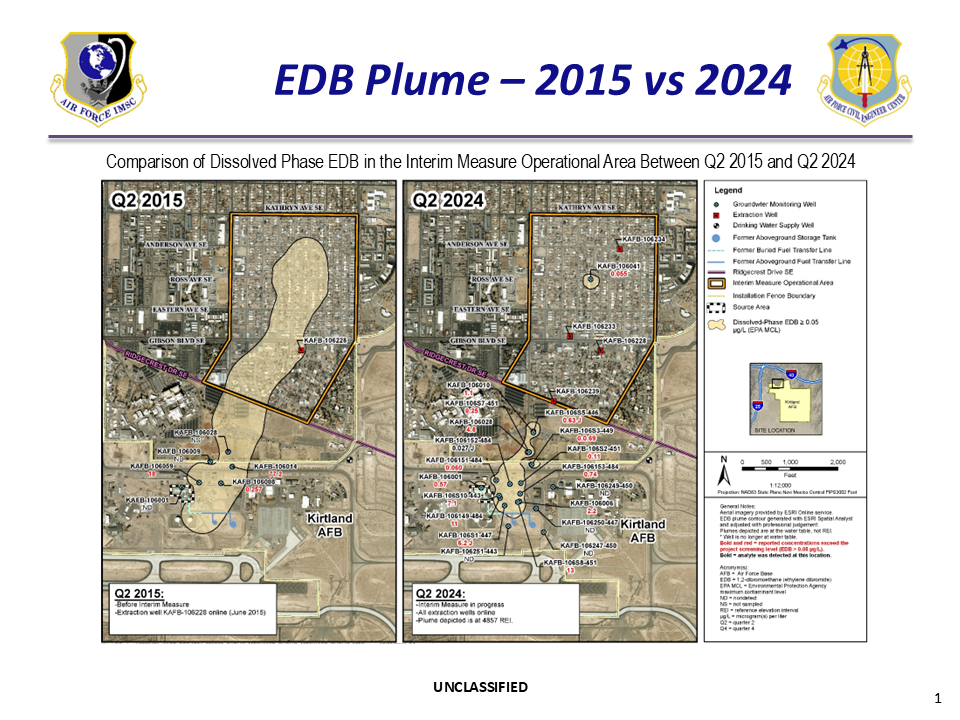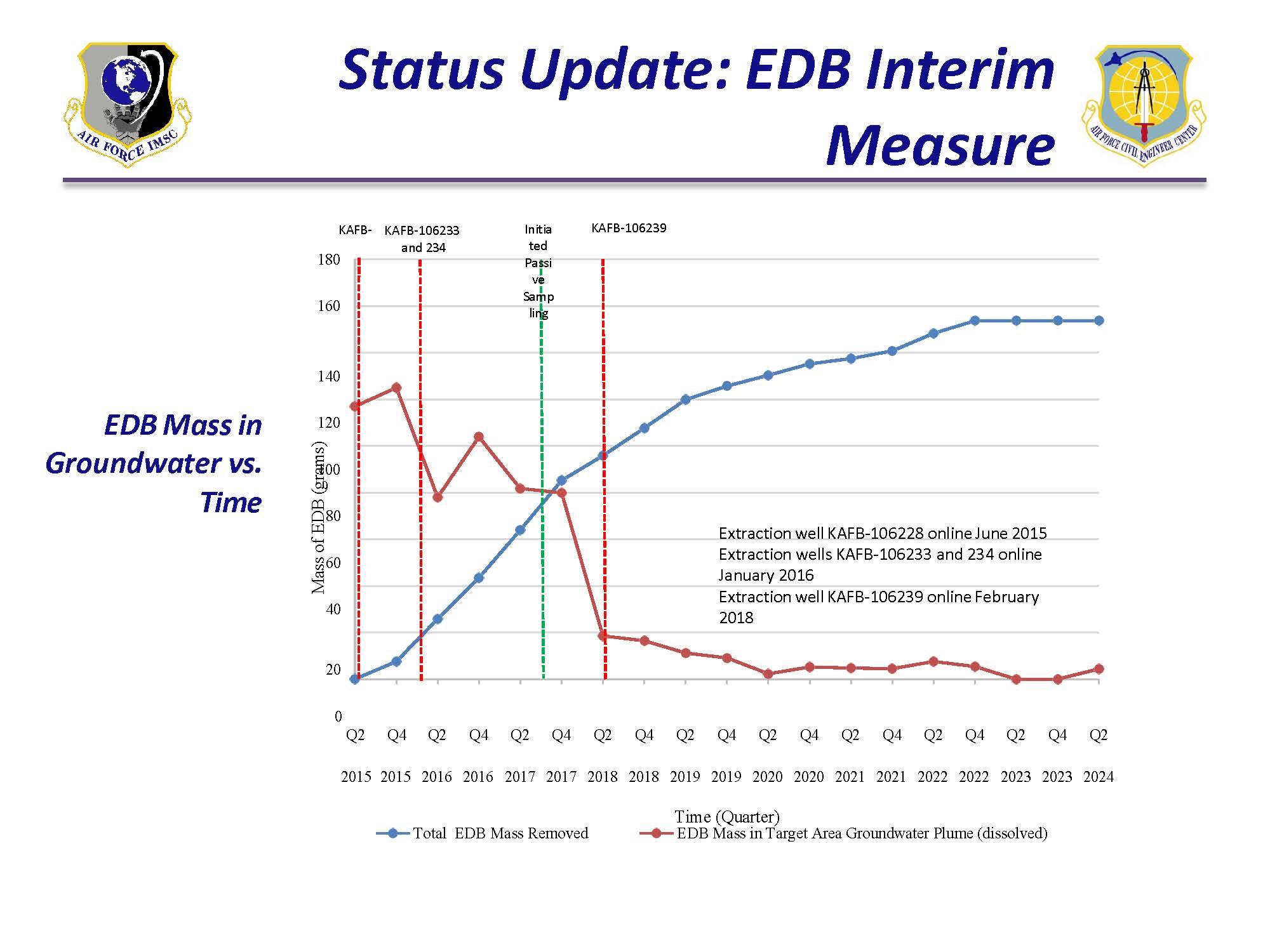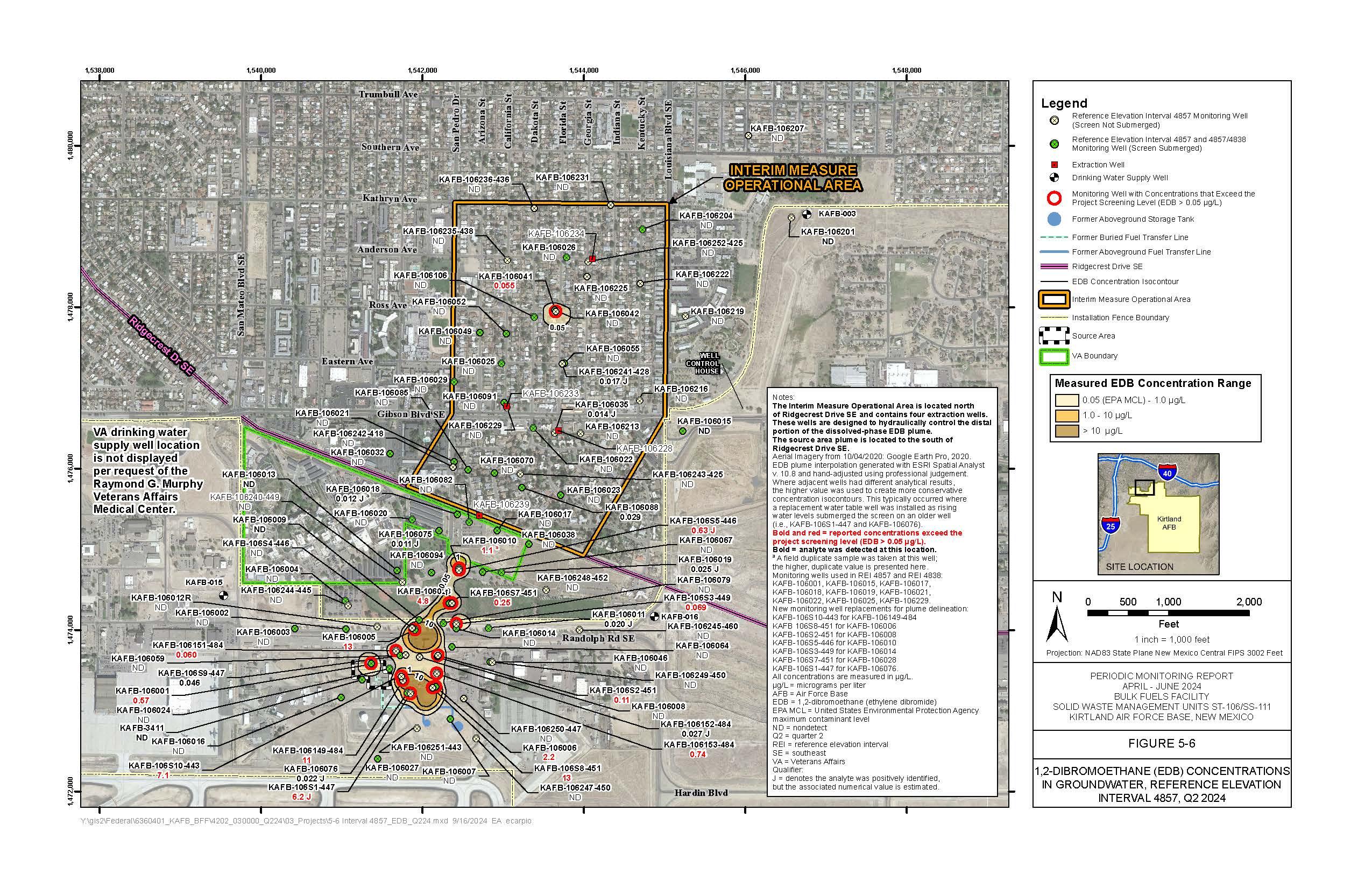This website provides information about the investigation and remediation work being done to address a release of jet fuel that was first detected at Kirtland AFB’s Bulk Fuels Facility in 1999. Generally, the contaminants of concern related to this release are called BTEX which is an abbreviation for benzene, toluene, ethylbenzene, and xylenes. These compounds are typically found in petroleum products. Of these contaminants, the primary environmental contaminants of concern are ethylene dibromide (EDB) and benzene. While these compounds may be the primary contaminants of concern, the other contaminants are being addressed and monitored at the same time as part of the remediation work. To ensure that Albuquerque’s drinking water remains unaffected by this plume, the Air Force continues to operate the GWTS and regularly samples the groundwater well monitoring network and community drinking water wells both on and off-Base. No contaminants have been detected in any drinking water well related to this site.
The US Air Force is conducting this work under a permit issued by the New Mexico Environment Department to:
- Identify the full scope of the release (plume investigation and characterization);
- Conduct interim cleanup activities (interim measures); and
- Propose and implement a final remedy for cleaning up soil and groundwater contamination (corrective measures evaluation and implementation).
The final recommendation for the cleanup will be forthcoming in the Corrective Measures Evaluation portion of the Resource Conservation and Recovery Act (RCRA) permitting process. Currently, an interim measure that consists of the Groundwater Treatment System (GWTS) is operating and has stopped further migration of fuel-related contaminants in the groundwater. An interim measure is a cleanup activity that is performed before the final remedy is selected during the Corrective Measures Evaluation and is part of the RCRA process. To ensure that Albuquerque’s drinking water remains unaffected by this plume, the Air Force continues to operate the GWTS and regularly samples the groundwater well monitoring network and community drinking water wells both on and off-Base.

- Continue routine sampling of groundwater and soil vapor monitoring wells – 174 groundwater monitoring wells and 67 nested soil vapor monitoring wells with 323 vapor points.
- Continue operation and maintenance of the Groundwater Treatment System.
- Continue working with the New Mexico Environment Department to move toward site cleanup of the source area (Corrective Measures Evaluation).
- Continue to report all data collected to the public.
EDB Mass in Gr oundwater vs. Time
oundwater vs. Time
The pump and treat interim measure has achieved an estimated almost 100% reduction in the interim measure operational area of the dissolved EDB mass since 2015. While EDB was detected in Q2 2023, the amount of mass was above zero but below the estimation criteria (less than 0.01 grams).
Pump and treat interim measure has achieved an estimated 92.4% reduction in the interim measure operational area of the dissolved EDB mass since 2016. EDB was not detected in Q2 2024, indicating no mass was removed during the quarter.
RCRA Process/Path Forward

- 1999: Upon discovery of the fuel leak, the former fuel offloading facility was closed and a new, state of the art facility with aboveground pipelines and capture systems was built and operational by 2011.

- 1999 to 2015: A total of 4,822 tons of contaminated soil in the source area above screening levels was excavated.
- 2000 to date: 174 groundwater monitoring wells and 67 nested soil vapor monitoring wells consisting of 323 vapor points have been installed for groundwater and soil vapor monitoring, both on and off-Base. This well network ensures the extent of the plume is identified and aids in monitoring the effectiveness of the groundwater pump and treat interim measure.
- 2003 to 2015: Use of a soil vapor extraction system and modified bioslurping on base. These systems removed an estimated 750,000 gallons of fuel and significantly reduced contamination in the vadose zone (the area underground between the ground surface and groundwater table). These systems were discontinued because the amount of supplemental propane used to run the system was significantly more than fuel pulled from the subsurface and minimal free product above the groundwater.
- 2015 to date: Groundwater treatment system (GWTS), an interim measure pump and treat system, was installed to extract and treat the EDB in groundwater that has migrated off-base, north of Ridgecrest Drive Southeast. The system has 4 operational extraction wells and successfully reduced groundwater levels of EDB to below detection limits.
- 2016 to 2020: Pilot in-situ EDB biodegradation test was conducted in the source area groundwater plume to determine the effectiveness of enhancing specific bacteria to breakdown fuel-related compounds in an anaerobic, or low-oxygen, environment.
- 2018 to 2020: Pilot bioventilation test was conducted in the vadose zone source area to evaluate the feasibility of this technology to address any remaining contamination. Effectiveness of this approach is determined by measuring how much dissolved oxygen is used by microorganisms in the subsurface, which is directly tied to the biodegradation rate of fuel-related contaminants in the subsurface.
- 2013 to 2016: Installation of USGS sentinel wells between drinking water supply wells and the project well network to monitor for fuel-related contaminants moving toward the water supply wells.
The Bulk Fuels Facility is located in the north-western portion of Kirtland Air Force Base (AFB) in Albuquerque, New Mexico. The Facility and associated infrastructure operated from 1953 until 1999. During that time, the fueling area was separated into a tank holding area where bulk shipments of fuel were received and a fuel loading area where individual fuel trucks were filled. Kirtland AFB removed the receiving facility from service in 1999 due to line leakage below the ground surface. Subsequently the entire fuel system was replaced.
Even though the fuel leak was identified by Kirtland AFB, the exact history of the leaks or releases is unknown. Releases could have occurred when fuel was transferred from railcars to the pump house, and then to the bulk fuel storage containers at the south end of the site. Initially, it was thought that the leak only affected surface soil around the identified source area. Kirtland AFB learned through additional investigation activities conducted between 2004 and 2007 that the leaked fuel had reached the groundwater table.
Vadose zone investigation activities began in 1999 and included multiple phases of soil sampling, borehole logging, well installation, and soil vapor sampling. Groundwater investigation activities began in 2000 and included multiple phases of installation, sampling, and analysis of GWM wells, slug testing, and aquifer testing. Completed interim measure and pilot testing activities for both the vadose zone and groundwater included:
- Excavation of 3,000 cubic yards of contaminated soil down to 20 feet below ground surface
- Multiple phases of soil vapor extraction
- Bioslurping for LNAPL removal from groundwater and soil
- Air sparge/soil vapor extraction pilot test
- In-site EDB biodegradation pilot test (groundwater)
- Bioventilation pilot test (soil vapor)
- Groundwater Pump and Treat System (continuous operation since 2015)
The GWTS began operating as an interim measure designed to protect potential future downgradient receptors (City of Albuquerque production wells). Pumping and treating EDB-impacted groundwater downgradient (downstream) of the source area prevented further migration and reduced the size of the groundwater plume. The GWTS has effectively removed EDB from groundwater in the interim measure operational area, with no detections of EDB in the influent (pre-treatment) groundwater since Q3 2022.